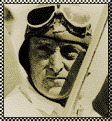
Sir Malcolm Campbell's cars and boats, all named "Blue Bird" are some of the most famous record setting vehicles ever made. It was in the second of the cars bearing this name that he set several land speed records in the United States and for which he was honored by induction into the Motorsports Hall of Fame.
Malcolm Campbell was born in 1885 in Chislehurst, Kent, England. He developed a passion for speed early in life, racing bicycles in Germany and achieving three gold medals in the London-Edinburgh motorcycle trials in 1906, 1907 and 1908. In 1909, he briefly became interested in airplanes, and finally in 1910 began automobile racing at Brooklands, England. In 1912 he adopted the name "Blue Bird" after seeing the stage play "The Blue Bird" by Maurice Maeterlinck. He considered this to be his "lucky" name, and thereafter all of his race cars and boats, as well as an airplane, were painted blue and named "Blue Bird." He was knighted in 1931.
Six new land speed records were established by Campbell between 1928 and 1935 in the United States at Daytona Beach, Florida and the Bonneville Salt Flats in Utah. The second "Blue Bird" car was first constructed in 1926, and established a new land speed record of 174.883 mph at Pendine Sands in South Wales. The car evolved over the years with each successive attempt at the land speed record. Its initial sleek and elegant appearance foretold the design of racing cars in the 1930s.
In 1928, Campbell drove this second "Blue Bird" to set the record at Daytona of 206.956 mph on February 19, 1928. Between 1931 and 1933 Campbell established three more land speed records there, ranging from 246.09 mph to 272.46 mph. The last record to be set by Campbell at Daytona was 276.82 mph in 1935. For these runs, "Blue Bird" was powered by a supercharged Napier aircraft engine.
Campbell's next goal was to set a 300 mph land speed record. The beach at Daytona was too short, and instead Campbell chose the Bonneville Salt Flats for the location of his final land speed record attempt. "Blue Bird" was again modified, with a resulting weight of almost five tons and a length of over twenty-eight feet. It was fitted with a Rolls Royce R-type 2500 horsepower engine, which had an estimated life span of three minutes at top speed.
On September 3, 1935, Sir Malcolm Campbell, at age fifty, piloted this last "Blue Bird," and set a land speed record of 301.13 mph at Bonneville. Due to timing and scoring problems, the speed was not confirmed until the next day as preparations were being made for another run. In later years he wrote that the excitement of setting that record was lessened due to the delay. The record stood for over two years. Campbell never again raced on land, instead turning his attention to setting World Water Speed records.
The Rolls Royce R-type engine from the second "Blue Bird" car was ultimately used in more that one of the "Blue Bird" boats which set several World Water Speed records in the late 1930s. Both of the land speed record cars still exist.
Sir Malcolm Campbell died on New Year's Eve, 1948, and the racing tradition was continued by his family. His son, Donald Campbell, became the first person to establish both Land and Water Speed records in the same year (1964). His granddaughter, Gina, achieved success in offshore powerboat racing.